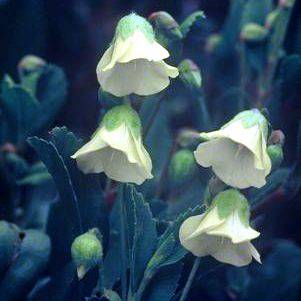
10 Hermannia saccifera Seeds - Komynbossie or Cumin Bush - Indigenous Evergreen Perennial
Check my rate
| Main centres: | 1-3 business days |
| Regional areas: | 3-4 business days |
| Remote areas: | 3-5 business days |

| Main centres: | 1-3 business days |
| Regional areas: | 3-4 business days |
| Remote areas: | 3-5 business days |
Common Names: Komynbossie or Cumin Bush
Hermannia saccifera is fairly widespread along the southern coast of South Africa, where it occurs on stony clay slopes from the Riviersonderend mountains and Bredasdorp in the Western Cape to Uitenhage in the Eastern Cape. In its natural habitat the plant is a low sprawling strangling shrublet to 400 mm, however in cultivation, although still a sprawler, it maintains a very compact habit, rarely exceeding 100 mm in height.The leaves are smooth, hairless, shiny, regularly toothed and bright green in colour. The flowers, usually 2 per peduncle, are bright yellow, pendulous, bell-shaped and cover the plant during spring (August to October) making quite a show. Hermannia saccifera was first described in 1858 as Mahernia saccifera by Turczanimow. It was later transferred to the genus Hermannia, by K. Schuman. Hermannia is named after Paul Herman (1640-1695), German professor of botany at Leyden and one of the first travellers and collectors at the Cape, while Mahernia is an anagram of Hermannia, although missing one of the n's, and has no significance other than that. The specific name saccifera is Latin and loosely translated means carrying or bearing a bag. It is known locally as the komynbossie (cumin bush), and honey made from the nectar is known as komynheuning (cumin honey), presumably because the flavour it gives the honey is reminiscent of cumin. Hermannia saccifera can be used as a groundcover, a container plant, or a hanging basket plant, and is suitable for coastal gardens. It works particularly well as a groundcover on a slope, hanging over a wall, in a rockery, or in terraforce walls. Hermannia saccifera is a medium to fast growing, evergreen, prostrate, mat-forming herbaceous perennial. It is best on a slope in a sunny position, in a neutral, well-drained, sandy loam soil. A single plant can be expected to cover one square meter in a year. Hermannia saccifera is wind tolerant, but is sensitive to frost and requires protection in the colder regions of South Africa. It also qualifies as a water-wise (drought tolerant) plant, and when established tolerates the winter rainfall - summer drought conditions in the Western Cape very well, but does require at least a weekly watering in summer. It has no major pests or diseases, and can be pruned to shape as required. You're buying a pack of 10 Seeds We'll supply you with all the germination & care instructions. |